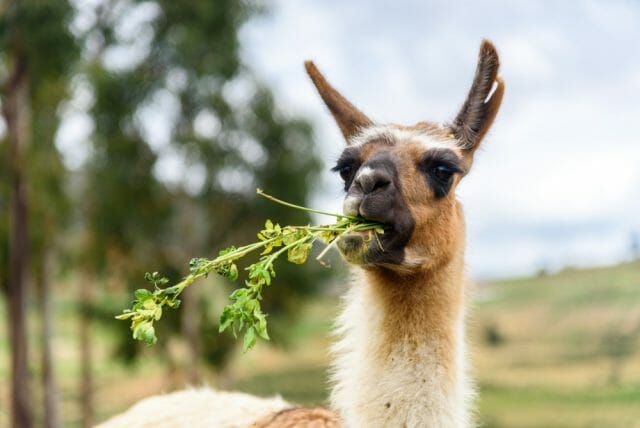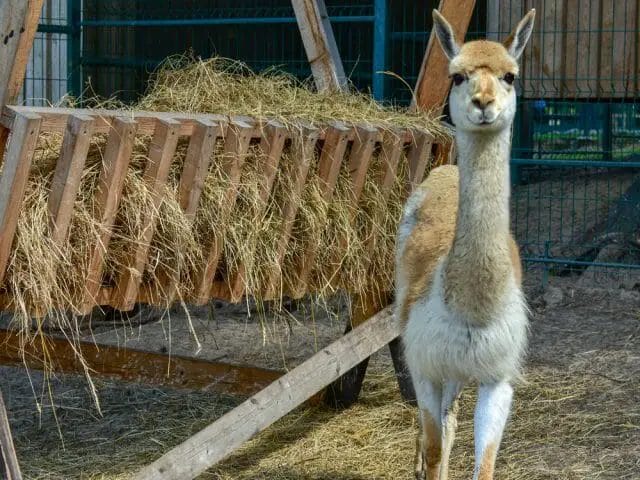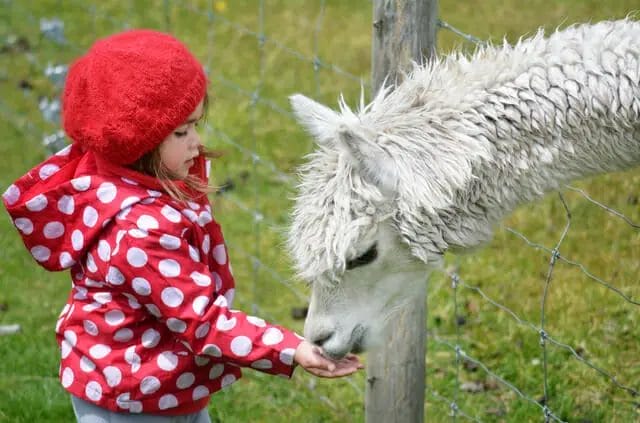Probably, there are not many people out there who don’t know about llamas. But a large chunk of people doesn’t know about the nature, habits, or the diet of llamas.
Many often classify llamas as niche animals with high maintenance. Hence, this is the reason why llamas are not on the top of the list.
Llamas are primary consumers, that means it mostly relay on plants. Herding llamas are pretty much the same as conventional animals.
However, the myths regarding the nature and food habits of llamas are the barriers. This is why we took a step to clarify the myths.
Hopefully, this will clarify the confusion and can answer ‘what do llamas eat?’
What do Llamas Eat for Food?
This is a list of daily diet for llamas. Later in this section I will discus about other types of feed for them i.e.. what treat they can eat?, what they eat in wild? and most importantly what not to feed them.
People often mistake by providing sheep foods. Though both of them are Graminivore or herbivorous, things that seep eats are not exactly same.
Now, it’s time to talk about the food habit of llamas in general. Of course, here we are referring to domesticated llamas, not their wild ancestors.
Domesticated llamas need to have a balanced diet to serve their purpose. That’s why their diet can be classified. Hopefully, this will also answer the question ‘what llamas like to eat?’
Here is the list of foods in domestic llamas daily diet.
1. Forage

There’s almost no doubt that forage is the staple food for llamas. They are herbivores and heavily depend on plants and grass.
Just like the sheep and goats, they will even eat flowing plants, shrubs, and veggies.
The quality of the forage is a severely limiting factor that determines how many llamas can be raised within an acre. Usually, the number roams between 3 to 5. Alfalfa, clover, etc. grasses are highly liked by llamas.
This grass provides proper nutrition. On the other hand, some plants (blackberries and dandelions) can provide sufficient nutrition.
2. Hay & Grain

It is no surprise that a species of animal that lives without meat will heavily be dependent on natural resources. Grains come in the first row of the natural blessings. Cereal grains are nothing but the seed of the plants.
Starch is a compound that can be digested easily. Plants store energy in form of starch.
That’s why starch is considered a great source of quick energy. That’s why, starch is needed for a living body, regardless of a human or an animal.
But consumption of excessive starch brings its downsides. Cereal grains can be readily fermented. Fermentation of starch can indeed provide glucose (the simplest form of crabs that a living mechanism can accept).
But starch also provides lactic acid. Undoubtedly, too much lactic acid accumulation can be lethal for the llama.
However, not all cereal grains provide the same amount of starch. And this is where the term “Energy Density” comes into play.
Some cereal grains have more starch accumulation than other counterparts. It’s wise to feed a moderate amount of those cereals.
The starch content in cereal is measured by the NFC (non-fiber carbohydrate). Scientists have found that corn carries up to 75% of NFC, while oats give 48%. TDN (total digestible nutrient) is measured to signify how much energy a cereal provides. Hay provides TDN up to 40% to 60%.
Cereal grains are generally used for bringing in an energy source to the regular diet of the llamas. This may be included with the supplements or forage.
3. Supplements
Supplements cannot readily replace the necessity of a complete meal. But a supplement is usually a complicated mixture of concentrates. Most of the owners want their lamas to be feed supplements along with forage.
Supplements are commercially available. These are prepared and marketed by agro brands. Not all of the supplements are meant for llamas but they can be used anyways.
Some giant farms tend to grow their supplements, especially targeting the llamas in the herd.
Most of the supplements of llamas and alpacas are marketed as pellets. They have typically smashed ingredients that are bound together.
Some experts argue that this technique may reduce the effectiveness of the fiber in the supplements. But these supplements make their way into the daily ratio of the llamas anyway.
a. Supplements for Maintenance Feeding
This is the most common form of supplements that most llamas need. In most of the regions, llamas are feed on forage. This is their primary source of energy with 8% to 10% CP in it. In this case, these llamas need vitamins and minerals as supplements.
But if the llamas in the heard have to walk a considerable distance per day, their supplement must have additional energy. In this case, the amount of protein should be 10% to 12%.
b. Supplements for show feeding
The llamas that need to do labor-intensive work, do need a special diet. Although the usages of llamas for carrying the load is declining, it’s worth knowing about the diet.
Anyways, these llamas need the energy to do hard work. Cereal grain (in a proper amount) is helpful to regain energy.
But consumption of too many grains can lead to obesity. So, a mixture of grains can be helpful. You can mix barley and oats with corn and then give them to the llamas. This will ensure that they don’t overconsume. Yet, they can get the required energy.
These llamas require an average amount of protein intake. This grain and protein intake along with regular forage consumption will ensure that they have enough energy to carry the load. Yet, don’t gain overweight.
c. Supplements for reproductive animal feeding
It is no wonder that a pregnant llama needs more food than usual. Lactating female llamas are also considered in this category. In this case, the protein must consist of up to 16 to 18% of the supplement.
Cereal grains are meant to be used as an energy source. These llamas need extra vitamins and minerals too.
Considerations
Supplements are subject to species, age, region, and food quality. The supplement that works for a herd may not do well for another.
Often the quality of the forage determines how many supplements are needed. It is wise to get in touch with a consultant to determine how much supplement a llama needs.
4. Salt
Almost all of us know the importance of salt as an electrolyte in the human body. The case is no different in an animal body.
Animals need to fill up their daily requirement of sodium and chloride. Salt is the easiest way that the requirement can be fulfilled.
Most of the animals need salt equivalent to 0.25% to 0.5% of the total consumed diet by an individual animal. Sometimes, animals show an abnormal craving for salt.
They will chew dirt, rock, or try to drink urine. This behavior is called Pica. Llamas are no different than other animals.
What form of salt is needed?
You can find salt products in two forms: compressed block products and loose granular. The latter one can be given to a llama with a concentrate mix.
Free block salts need to be licked. This process results in efficient management but llamas are unable to intake the required amount of salt by this mean.
The nutrition from a source largely depends on the composition. Salt is no different. There are not sufficient differences between block salts and the loose counterpart, except the physical appearance.
The recommended process of feeding adequate salt
- A source of loose granular salt must be present in a continent location for the llamas. That pot must be covered well for rain protection.
- You need to provide only a kind of salt at a time. Usually, llamas need salt for sodium. It can be filled up with white salt. If you need to provide a trace mineral source in form of trace mineral salt, do not put it with white salt. This will help the llamas to intake the necessary sodium they need and not be confused with trace mineral salt.
- Water source is necessary to efficiently intake any food source. But it’s better not to place salt and water source too much close to each other.
- Calculate the salt requirement by inspection. The inspection period may be as long as 30 to 45 consecutive days.
- Try to make a balance of salt intake of the llamas with their forage intake. If the forage provides less amount of minerals, it’s more likely to add salt to the diet.
5. Water & Drinks
In case of wild and free-range llamas can live long time without water. That is because they can acquire hydration by consuming plants.
However, farm llamas will require much water then the wild ones.
Now, beverage and alcoholic drinks are toxic to them. Learn more about the toxic foods.
What do Llamas Eat for Treats?

What llamas can eat for a treat and what cannot- is one of the greatest considerations for the owner. This factor has to be considered before any public gathering on the farm, it may be during showtime.
As most llama owners tend to organize public gatherings from time to time, they know their llamas will receive treats from the guests. Often, these treats are relatively hard for the llamas to digest.
But undoubtedly, llamas are fond of vegetables as well as fruits. But as llamas don’t have the top front teeth, they cannot chew apples or carrots. Rather their teeth are calibrated to eat grass and likely chewable items.
It is a wise decision to cut carrots and apples before presenting them to the llamas. Llamas will be able to chew and digest these veggies and fruits. That’s how you are supposed to give a treat to llamas.
List of Treats for Llamas
List of vegetable for them
- Carrots
- Broccoli,
- Sweet potatoes,
- Pears,
List for fruits for them-
- Apples,
- Oranges,
- Bananas,
- Grapes,
- Watermelon,
- Mango,
- Melon,
What do Llamas Eat in the Wild?
Llamas are domesticated by humans well before. Undoubtedly, llamas lived in the wild and could collect their food. Llamas were then found in the South American regions. They had a connection with the Andes Mountain and surrounding regions.
But now llamas are no longer found in their wild habitat. However, they still possess some of their wild treats. That’s why learning about their wild nature is important.
Most of the researchers confirm that llamas were vegetarians even back then. They lived on plants, shrubs, and veggies. Back then the access to grains was severely limited for llamas. Yet, they managed to survive on plants or likely vegetables that they can find.
Foods That are Toxic for Llamas?

Llamas are fond of grazing around and take forage. In this search, they can accidentally intake food that is toxic for them. As like goat feed list, there are some toxic feed form them.
Algae
Apart from plants, they may come across Algae. Especially, blue-green algae in slowly moving water can be lethal. This phenomenon occurs mostly at high temperatures. Algae can create allergic reactions. It can attack the underbody, ear, and muzzle inflammation. One of the symptoms is constipation. However, algae inflammation may not be lethal if proper treatment is given at right time.
Metal
Llamas can suffer from copper toxicity. It is an indication of too much copper in the mineral intake. Besides, they can suffer from lead contamination.
Mycotoxins
This term refers to fungi-related issues. Warm and moist environment accelerates the process. Mold reproduction in a moist environment increases the chance of such contaminations. Pregnant and young llamas are the most vulnerable.
Pesticides
As llamas want to eat forage, they often tend to be attracted to appealing grass or plants. But sometimes these may contain a harmful amount of pesticides and herbicides. This leads llamas to nerve-related issues. Sometimes, they require a quick response with the right antidotes to get rid of the contamination.
Selenium
This particular contamination has a relation with soil. But llamas receive this contamination through plants. Lack of liveness in the llamas is the primary symptom of the contamination.
How Much do Llamas Eat Daily?
Llamas don’t need a ton of food regularly. Even they need less food than an average cow. They often eat merely forage to satisfy their need. This may be sufficient if proper vitamins and minerals are present. But if not, they need to be accompanied by supplements.
Llamas need a different amount of food during different stages of their lives. You cannot make it generic. The effort they put get the diet has a significant impact. Besides, the amount of work they have to do is a factor. However, a llama requires about a gallon of water daily.
Bottom Line
Llamas are attractive animals that can attract a lot of attention and even be useful. But it’s up to the owner who can make the difference by providing his/her llamas with ample food.
It’s always wiser to consult a nutritionist for the daily diet and supplements for the llamas. This will ensure a balanced diet for the llamas and as a result healthier livestock for the owner.
